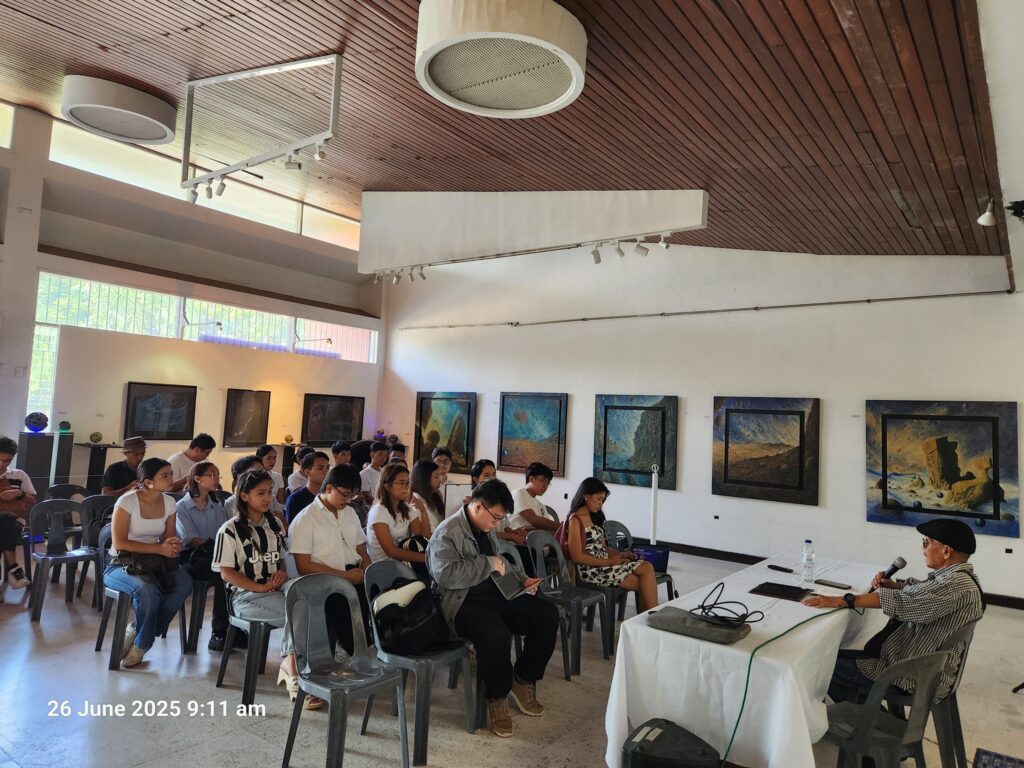The dominance of Manila as the center of the Philippine art scene has long defined the narrative of success and visibility of Filipino artists. But this centralism might soon be yielding to a counter-current: the gradual rise in regional consciousness fueled by policies, access to information, and the immediacy of communication in the digital age. These factors could perhaps aid in breaking the invisible barriers that separated the regions or the periphery, from the center.
On a positive note, what could soon be the outcome of this counter-current is a new landscape rich enough for genuine exchange. It is within this context that Ugnayan, an artist-led project, was born.
According to one of the organizers, Orland Espinosa of Hiugyon Creatives, the project’s genesis stemmed directly from a challenge. With the urging of prominent Manila-based artists Manny Garibay and Leslie de Chavez to initiate exchanges with organizations like Garibay’s Linangan Artist Residency and de Chavez’s Project Space Pilipinas, Espinosa and his group organized the first Ugnayan in 2024. The first iteration was a series of talks held at the University of the Philippines Visayas – Museum of Art, Culture and Heritage.

Risking paternalistic tendencies, Ugnayan experimented on peer-to-peer dynamics and hoped to recalibrate what was previously seen as an imbalanced dynamic. Learning from similar projects in the past and navigating the sensibilities of the territorial tumandok or locals, the project attempted to move beyond the paradigm of the region simply being “discovered” by the center, and toward a praxis of mutually beneficial collaboration built on shared intention to learn from each other.
For its second year, Ugnayan, themed “Paghiliusa” (a Hiligaynon term for unity), again attempted to manifest the praxis into a four-day event held last June 26-29, 2025. Its four components—a public mural, a series of talks, a group exhibition, and two outreach events—were organized to initiate different modes of interaction. The event also received support from the Iloilo City government for the mural, and Manny Garibay personally backed many of the other activities.
The mural, in particular, is more than just public art; it is a manifestation. Espinosa notes that murals “let the public know that there are artists living and working in a place,”. It is an act of attempting to claim civic spaces and asserting cultural presence. Espinosa also recalls drawing inspiration from Garibay, whose large-scale murals have transformed public walls. For him, an early experience participating in a mural project in Marikina set an example of organizing the community as part of an art practice.
The creative process behind the making of the Ugnayan mural is a microcosm of its collaborative ethos. Representatives from the nine participating artist collectives sat together and discussed what Ilonggo identity means for each of them. From this discussion, a resonant concept emerged: the focus on food and the salo-salo (gathering or feast) in community life. This became their conceptual springboard. Artists sketched their ideas, and later agreed on a composition: a long table populated by people from all walks of life, even including tourists. This inclusion, according to Espinosa, is an acknowledgment that contemporary local identity is not a static, hermetically sealed concept. As Espinosa explains, it recognizes the contributions of visitors and transient populations as active agents in shaping the cultural fabric of a place.
Complementing this public-facing aspect of Ugnayan is the series of talks and workshops that aim to strengthen the regional art scene from within while building external bridges. In partnership with Museo Iloilo, Hiugyon invited Ed Defensor to speak on the crucial topic of sustaining an art practice rooted in the locality, while artist Arel Zambarrano offered an important survey on the contemporary state of art in the city. These sessions provided a vital platform for local self-assessment and historical consciousness. Simultaneously, workshops by visiting artists like Art Sanchez, Otto Neri, and Manny Garibay hoped to facilitate a direct transfer of skills and techniques.
Ugnayan expanded more seats at the table, so to speak, by tapping artists from the nearby town of Tigbauan and the province of Guimaras to host events. In a way, the project demonstrates a nuanced understanding of regionalism in Western Visayas in particular. It somehow positioned Iloilo City not merely as a recipient of exchange with Manila, but as a center in its own right, capable of fostering and disseminating knowledge within its own sphere of influence.
This model may just be a way to counter the historical “brain drain” that uprooted provincial talent to the capital, proposing instead a polycentric network where artists can thrive locally while remaining nationally and even internationally connected. Ugnayan, therefore offer a replicable blueprint for a more equitable and integrated Philippine art world, one built not on a singular center, but on a balanced ecosystem of vital, collaborating communities.